
The British civilian service gas mask was not issued to the general public, but to the Civilian Defence and other official bodies (for example, the police). They used the same filter as on the standard civilian-issue mask, but were of a different design and produced to a higher standard. Unlike the cheaper civilian-issue type, each part could be replaced in the event of damage. Another feature was the existence of a 'stub' on the left hand side of the mask, which allowed for the easy conversion to accept a microphone for use with telephones. Please click here to view our example.

They were issued in a cardboard box, which gave details of mask size (small, normal or large) embossed on the lid. The box contained the mask, a carry bag and de-misting kit (the small green tube shown in the image with the mask and bag). The bags were of a variety of colours, although the canvas type shown here was the more common; along with a green hessian type later in the war.
The exhaled breath was released by means of the 'flutter' valve on the front of the mask, between the eye-pieces and above the filter. The green filter extension on the front provided protection against more gas types than the mask was originally designed for. They were prone to misting up as well as the weight of the filter causing the mask to slip down when worn for extended periods.
Recently, it has been made known that the filters of WW2 gas masks contain asbestos; because of this you should NEVER wear a mask and consult a professional for SAFE DISPOSAL in the event of the mask becoming damaged.
Back

Ointment Anti Gas No.2 tin. These ointment tins were carried with every service respirator during the early part of WW2 until replaced with newer versions.


